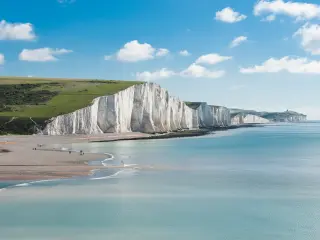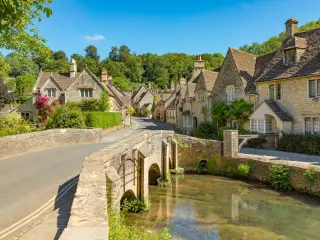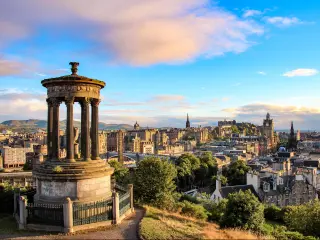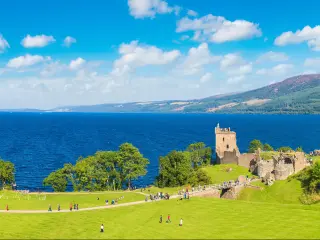Road trip from London to the Lake District
The road trip from London to the Lake District is a trip packed full of history and the beautiful British countryside. You'll get to spend some time in at least one of the northwest's buzzing major cities as well as exploring picturesque small towns and villages that are dotted along the route.
A 310-mile road trip from London to the Lake District takes 7 hours to drive. Notable stops are St. Albans, Windsor, Oxford, Cheltenham, Birmingham, Bakewell, Chatsworth, Chester, Cotswolds, Peak District National Park, Manchester and Liverpool.
This picturesque road trip boasts awe-inspiring sights you would expect from the English countryside and urban attractions to keep it varied. Read on to find our suggested routes, the best things to see and beautiful places to stay as well as the best time to make this road trip.
How far is the Lake District from London, and how long will the road trip take?
| Route | Distance | Driving Time |
|---|---|---|
| The Direct Route | 310 miles | 7 hours |
| The Peak District Detour | 330 miles | 8 hours 15 minutes |
| The Scenic Route | 350 miles | 9 hours |
There isn't a vast difference in time or distance between these three routes, but even adding an hour or two onto your journey will give you countless more things to see and do along the way.
The fastest and the most direct route will take you 7 hours to drive, covering 310 miles without accounting for any stops or detours.
If you'd like to marvel at the picture-perfect Peak District, the route will cover 330 miles with 8 hours and 20 minutes of nonstop driving time, but you will want to add extra time to take breaks and sightsee.
Our longest recommended route is the Scenic Route, which is well worth the added mileage. This stunning route will take you through Cotswolds and cover 350 miles, taking 9 hours to drive.
While you can drive each of the routes within a day, that doesn't give much time for detours or exploration. We, therefore, suggest taking at least 3 days to drive from London to the Lake District.
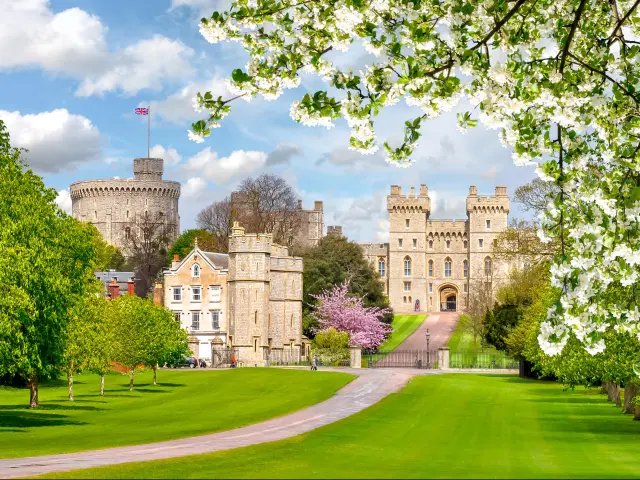
Best road trip route from London to the Lake District
The Direct Route is the quickest route, as it follows the motorway most of the way. It takes you through some of the towns and cities that were instrumental in shaping Britain's industrial heritage.
For much of this route you won't be driving through the beautiful landscapes and picturesque rural towns that you'll enjoy on the scenic route – but you'll make up for this as you approach the Lake District.
The Peak District Route will take you through UK's first national park, which is a vast area of stunning, hilly scenery. There are only two mountains in the national park – Kinder Scout and Bleaklow – but with many lower-level hills and valleys to explore, it's a hiker's paradise.
This detour only adds more than an hour to the driving time, but most visitors will want to spend at least a day or two enjoying the fabulous landscape.
The picturesque Scenic Route travels through a series of historic and quaint towns where you can explore castles, universities, Roman ruins, regency spa towns and mediaeval cities.
As well as enjoying the beautiful countryside, there's plenty to see and do in the larger towns along the route. You'll follow stretches of single-carriageway (2-lane) roads through rural areas, so you might be slowed down if you get stuck behind a tractor.
The Direct Route
Take Motorway 1 (M1) and Watford Road out of London, heading north to St. Albans. This charming city hosts many Romanesque features including a centuries-old cathedral. Keep going north on the M1 and the A5 to Bletchley Park, which is home to a large Victorian mansion that is worth visiting.
Leaving Bletchley Park, continue northwest on the M1, heading to Birmingham, driving past Coventry. Following the motorway north through Stoke-on-Trent will take you to Manchester, where you can spend some time visiting its many museums, shops and eateries.
Next, head on the motorway through Preston and towards the Forest of Bowland. You can make a detour to the picturesque cliffs of Arnside and Silverdale past Carnforth and enjoy some coastal scenery.
The final leg of your journey will take you northwest, between the Irish Sea Coast and the Yorkshire Dales National Park. You'll then reach your destination on the shores of beautiful Lake Windermere.
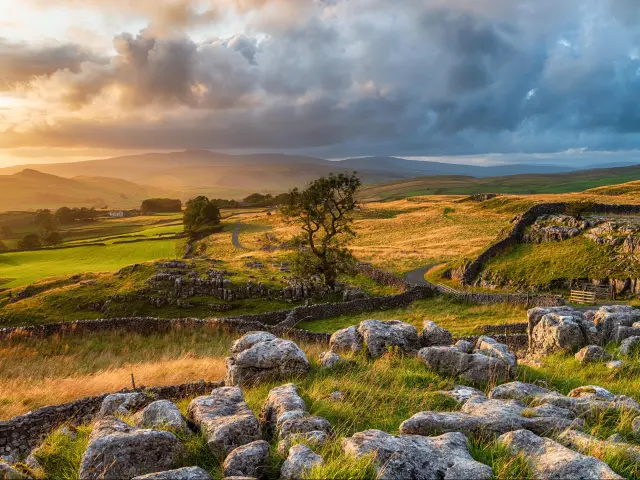
The Peak District Detour
This route follows the same directions as the Direct Route until Birmingham, where you'll head northeast, towards Bakewell in the Peak District National Park. This is a fantastic stop for a walk, where you can walk up to Kinder Scout, the highest moorland plateau in the park.
You can also visit Chatsworth House here, which has been the home of the Devonshire family for many generations. After your visit, drive diagonally across the national park, going northwest towards Manchester.
From here on, you will follow the same directions as the Direct Route to reach your destination in the Lake District.
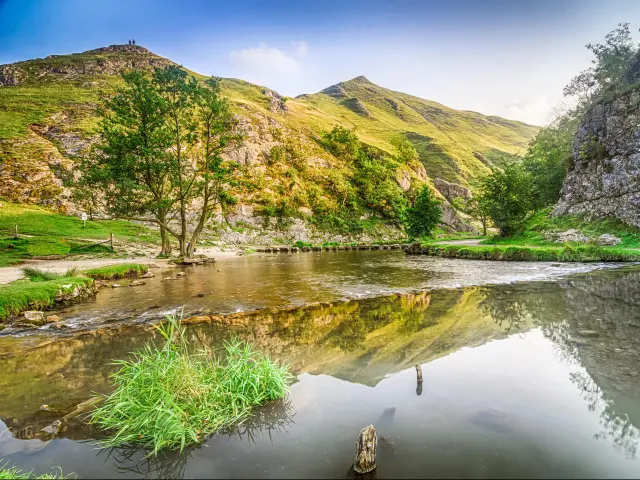
The Scenic Route
Leave London heading west, through Colne Valley Regional Park. Follow the A4130 south to Henley-on-Thames, at the edge of the Chiltern Hills Nature Preserve.
After spending some time here, drive across the nature preserve in a northwesterly direction to Oxford. Famed for its university and architecture, Oxford is a great place to stop for a wander.
Continuing northwest, you'll drive through the incredibly scenic Cotswolds and its charming old-worldly villages. Upon leaving the Cotswolds, you'll arrive in Cheltenham, best known for horse racing.
Staying on a northwesterly route, you'll pass the Malvern Hills Area of Outstanding Natural Beauty on your right. Follow the A49 to Ludlow and Church Stretton in the Shropshire Hills. Stay on the A49 to Shrewsbury.
From here, head to Liverpool and enjoy an urban break and visit the Tate, if you have the time. The last part of your route will curve slightly inland, then north past the Forest of Bowland and into the Lake District National Park.

Best places to stop between London and the Lake District
You will pass through many picturesque villages and bustling urban centres that you will be spoilt for choice as to where to stay. Here are our top overnight stop suggestions, featuring amazing attractions and stunning landmarks to keep you busy.
An urban break in Manchester
2 hours from the Lake District on The Direct Route is Manchester, a vibrant city with plenty to see and do. Once an industrial powerhouse, Manchester has reinvented itself as a thriving modern city and is known as the home of two of the world's biggest football clubs.
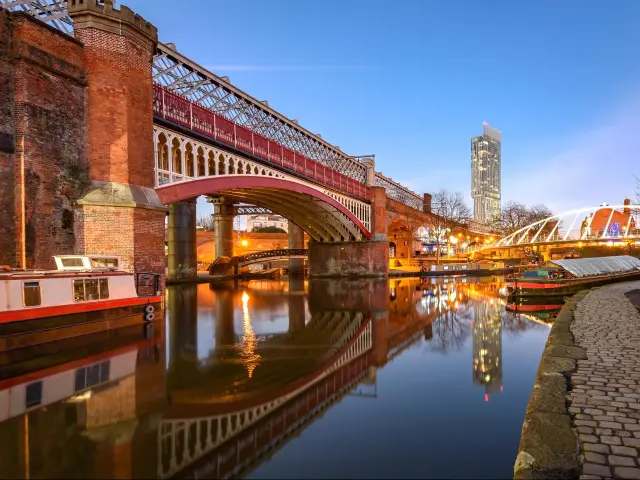
Tour one (or both) of Manchester's major football stadiums. If football isn't your thing, you can also visit some of the city's museums, including the Museum of Science & Industry, the Imperial War Museum and the People's History Museum.
Seek out street art, vintage treasures and independent coffee shops in the bohemian Northern Quarter. If you have more time you can also take a boat trip along the Manchester Ship Canal to see the city's heritage buildings firsthand.
If you want to enjoy the city's urban centre and its buzzing nightlife, it makes sense to have accommodation nearby. Native Manchester is located in a former warehouse with many original features carefully maintained during its renovation.
Striking industrial design and stylish features that can be found in its spacious rooms are an unexpected bonus for a city centre location. There's a yoga studio, independent cinema and café nearby that you can take advantage of during your stay.
Parking is available, which takes some of the stress out of arriving in a big city. Manchester Piccadilly Train Station is a short walk away, giving you access to the entirety of the city.
Explore the historic heart of Oxford
Around 90 minutes out of London on The Scenic Route is Oxford, the perfect first-night stop. It's one of the top UK destinations for visitors, and a must-see stop on this route with its world-famous 900-year-old University.

The city also is home to world-class museums and offers you a chance to row on River Thames. The Ashmolean Museum was the country's first public museum which now houses exhibits from across the world, including innovative temporary exhibitions.
You can take a tour of the prestigious university and catch a glimpse into the quads, libraries and staircases of this ancient and beautiful institution. See how many Harry Potter filming locations you can spot too!
If you're into punting, follow the river out into the surrounding countryside then pull up at a riverside pub to enjoy a glass of Pimm's or local ale. Following the riverbank that overlooks Christ Church Meadow, the Oxford Botanic Gardens offer a peaceful retreat.
The Old Parsonage Hotel is an Oxford landmark known for its beautiful design and attention to detail. Rooms are classically decorated, and there's a sense of sophisticated elegance throughout. This beautiful building has two terraces and a new resident garden library, as well as an upscale restaurant and a bar on-site.
The hotel is within walking distance to the city centre, colleges, river and an excellent choice of restaurants, bars and cafes, including the Covered Market. It can be easily accessed from the main road through Oxford, which makes it super easy to return to your road trip the next morning.
Where to stay when you reach the Lake District
Cragwood Country House Hotel in Windermere is right in the centre of the Lake District, with views across Lake Windermere. It boasts spacious and comfortable rooms with large and well-kept grounds including acres of landscaped gardens.
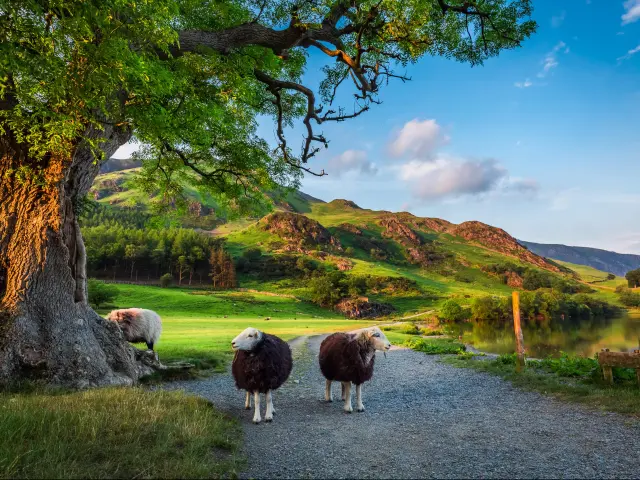
The interior and exterior decor give it a feel of a luxury English country manor, so you will be steeped in character and charm here.
Restaurants are within walking distance and Windermere is a short drive away. Attractions such as the World of Beatrix Potter, Windermere Steamboat Museum and the Lakes Aquarium at Newby Bridge are nearby.
Things to see on a road trip from London to the Lake District
Whether you're into museums, hiking, city sightseeing or a vibrant night scene, we've got you covered with our complete lists of things to see on each of our routes.
The Direct Route
- St. Albans - This small and historic city just north of London has Roman roots which you can find out more about at the Verulamium Museum.
- Bletchley Park - This country house famously housed some of the world's best codebreakers during WW2, and the fascinating museum here now tells the story of how their intelligence helped the Allies win the war.
- Silverstone - Motorsports fans should definitely make the detour to Silverstone, home of the British Grand Prix, where you can view motorsport memorabilia and try out interactive exhibits. Check in advance for dates of heritage walks where you can learn more about the history of the track itself.
- Coventry -The centre of Coventry was famously devastated during the Blitz, with the historic cathedral receiving a direct hit. Now its ruins remain as a war memorial, while a modern cathedral stands next door. Coventry is also known for its motor industry, and the Transport Museum here reflects on those roots.
- Birmingham - Birmingham has a thriving cultural scene and is home to the world class Birmingham Symphony Orchestra, Birmingham Royal Ballet and the Barber Institute of Fine Arts. For more quotidian pursuits, head to Cadbury World in the south of the city to celebrate all things chocolate, or check out the vast Bull Ring shopping centre, known for its modern design.
- Shugborough Hall - Located on the edge of Cannock Chase Area of Outstanding Natural Beauty, this large estate (now maintained by the National Trust) includes a working farm, extensive gardens and an exquisite mansion.
- Stoke-on-Trent - Some of the finest bone china in the world was produced in the Staffordshire Potteries, and the award-winning Gladstone Pottery Museum is located in a real Victorian factory where you can learn more about the industry and the region's heritage.
- Alton Towers -Thrill seekers should check out this huge resort and theme park, set in the beautiful Staffordshire countryside.

The Peak District Detour
- Lichfield - This small city is known for its triple-spired cathedral and the many historic buildings in its centre, and hosts the Lichfield International Arts Festival alongside folk, jazz and blues and real ale festivals each summer.
- Great British Car Journey - The Midlands are the traditional home of the British car industry, and this interactive museum has over 100 classic cars from British manufacturers on display.
- Bakewell - Enjoy an afternoon tea and a famous Bakewell tart (or lesser known Bakewell pudding!), a walk by the river and a stroll around the historic centre of this charming small Peak District town.
- Chatsworth - Voted Britain's Favourite Country House, this striking building and estate has been home to the family of the Dukes of Devonshire for nearly 500 years. The fabulous state rooms and vast estate are well worth a visit.
- Eyam - The tiny village of Eyam went down in history when its residents went into quarantine following the arrival of the Plague in 1665, to protect nearby communities. There's a museum in the village which explores its history. There's also a challenging walk through Eyam and Abney which offers some more fabulous views of the Peak District.
- Castleton - This picturesque village nestled in a valley is the starting point for a number of great hikes. It also has a ruined castle, underground caves and a plethora of pubs and tea shops to explore.
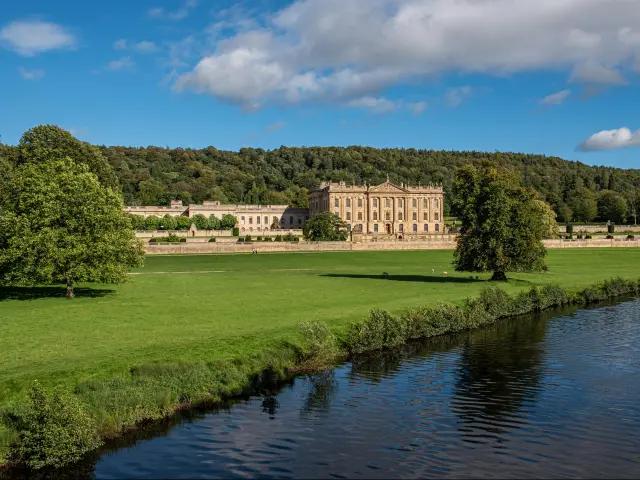
The Scenic Route
- Windsor - Not far out of London, hop off the motorway to visit Windsor and explore the royal locations of Windsor Great Park and Windsor Castle.
- Henley-on-Thames - River Thames provides a picturesque focal point for this small town, which is known as the home of world-class rowing crews.
- Cheltenham - Known for its characteristic Regency architecture – you can still visit the Pittville Pump Room, where Georgian aristocracy came to drink the supposedly restorative spring water – and the annual Gold Cup horse race, Cheltenham is also home to a number of art galleries and the Gustav Holst Birthplace Museum.
- Ludlow - This Shropshire market town includes some beautiful mediaeval buildings and the ruins of Ludlow Castle, as well as many fascinating antique dealers and independent shops.
- Church Stretton - This vibrant market town sits at the centre of the Long Mynd and the beautiful Carding Mill Valley, part of the Shropshire Hills AONB. The half-timbered buildings in the town's marketplace aren't original – they were rebuilt following a fire in the 16th century.
- Shrewsbury - Take a walk through the Quarry along the banks of the River Severn then follow the winding road up to the top of the hill past boutique shops and eateries. You can also visit the remains of the town's castle, and its Abbey, which is still a working parish church.
- Ellesmere Port - Take a detour to visit the National Waterways Museum, housed in the listed buildings that line canals which were once the beating heart of the industrial revolution.
- Chester - The striking black and white timbered buildings of Chester are surrounded by 2 miles of 2,000-year-old Roman walls, and the Dewa Roman Experience is the ideal place to learn more about this period of the city's history. There's also a cathedral which dates from 1092.
- Liverpool - Take a trip back in time while in Liverpool, starting with a visit to the Beatles Story and the famous Cavern Club or one of the city's other buzzing clubs and bars. Then take a walk around the docks to see the iconic Liver Building.

Best time to go on a road trip from London to the Lake District
With cool summers and mild winters, the Lake District gets a lot of rain all year round. In fact, it's one of the wettest places in the country (which is saying something!). So, while you probably won't want to visit in winter if you're planning on spending your trip hiking, don't let the rain alone put you off visiting in the cooler months.
The average high temperature in July and August is 19 degrees Celsius. It can be extremely busy in summer; beauty spots become crowded, popular walking paths are busy, and parking spaces are at a premium.
Accommodation prices rise, and it's advisable to book well in advance for trips during the July-August school holiday. All through the summer months, the different towns host agricultural shows, which showcase local crafts, produce and livestock.
Winters in the Lake District are mild, with average low temperatures around freezing and daytime temperatures averaging 6 to 8 degrees Celsius. The higher peaks can see regular snowfall, so check local information for conditions if you're planning on hiking.
High winds can also be a factor in exposed areas. Kendal Mountain Festival in November is for lovers of the great outdoors. This annual event celebrates the climbing, hiking and watersports that make the Lake District so special.
In December, towns and villages across the area run festive markets, including Windermere, Keswick and Ambleside.
Spring remains cool, with temperatures only rising to an average of 13 degrees Celsius by May. On average, March and April are the driest months of the year, although rain is still possible. Keswick Jazz Festival, a long weekend filled with jazz performances and talks, is in May.
In autumn, the temperature drops off sharply again, down to an average 8 degrees Celsius by November. It's possible to see snow on the highest peaks from November. October to December are the wettest months.
Taste Cumbria Food Festival in September is an annual event showcasing the ample local produce available. Penrith Winter Droving is a unique celebration of local customs, with an illuminated parade and street performances taking place in October.
Accommodation prices are usually lower in spring and autumn, as the summer crowds disperse, so for many people, this is the best time of year to visit. Given that it rains all year round and never gets really hot, the cool temperatures probably shouldn't be a deal breaker.

